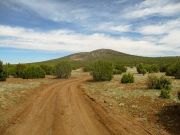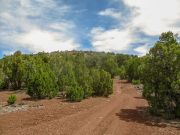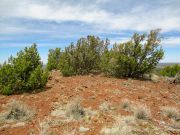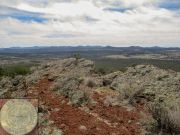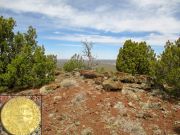
The Mountains of Arizona
• www.surgent.net
|
| Ortega Mountain |
• White Mountains • Springerville Volcanic Field • Sitgreaves National Forest • Navajo County |
|
Date: April 18, 2020
• Elevation: 7,007 feet
• Prominence: 497 feet
• Distance: 3 miles
• Time: 90 minutes
• Gain: 675 feet (gross)
• Conditions: Sunny and warm, but with high clouds and a stiff breeze.
Arizona
•
Main
•
PB
•
LoJ
•
USGS BM Datasheet
•
Interactive map
Ortega Mountain was the fourth peak I hiked today, coming over from Cerro Montoso and its northern neighbor. It was still not yet noon and none of my hikes had been very long, although they were steep. I was feeling tired but energetic for one more good hike, then I'd head back home.
There's nothing remarkable about Ortega Mountain except that is was convenient, rising just a mile and a half north of US-60 with decent forest-road access. From Cerro Montoso, I drove about ten miles westbound, looking for Sitgreaves Forest Road 9055. Ortega Mountain is the obvious rounded hill in the near distance, there being no other hills, bluffs or bumps nearby.
Like all the other hills in the region, Ortega Mountain is a mound of volcanic rubble. The approach road and hike lie in the Sitgreaves National Forest, but the summit lies mere feet outside the forest, on State Trust land. I found FR-9055 and rolled in, the road being uneven and rutted, but not rocky. I drove in not very far, perhaps 500 feet, but far enough to park hidden among the pinon and juniper.
I was walking by 11 a.m., the day sunny with clouds, temperature about 55 degrees, and a strong breeze that never let up. In the sun, it was warm, but the breeze had a bite to it. I followed FR-9055 northbound. The road drops about a hundred feet in the first half mile, bottoming out near a creekbed, which today was a mix of mud and pools of water from last weekend's storm. Otherwise, the road in was okay, but heavily rutted. I could have coaxed my car to this lowpoint, but it would have been a chore and not worth the time.
Past the puddles, the road ascends, bends a little to the left, then the main route takes off due west, this being FR-9055A. I stayed north on FR-9055. By now, the road was actually two or three parallel tracks of varying ruttedness. Random roads would split then merge. I just guessed and always took the one that aimed toward the mountain, now much closer.
Here, the road angles a little northeast, then bends northwest and starts a moderately steep uphill grind to top out on a small saddle below Ortega Mountain's main mass. I stayed on the road and followed its continuation, now heading directly uphill on Ortega's southwest-facing flank.
This portion was steep, gaining 200 feet quickly. It was loose and unkempt, and I slipped a few times on the volcanic gravel. But it was brush-free. I soon came to its end at a fence line no more than 30 feet below the top rocks. This is the north boundary of the forest. I found a convenient place to step over the wires, now on state land.
I stayed on meager paths and came upon the summit rocks, finding an easy passage through them. I would not call this scrambling, but the rocks were loose and I needed my hands a couple times. The top was flat, with a couple trees growing on it. The north and south rims were lined in larger agglutinate rock. I walked to the northern rocks, which I felt were the highest points. Here, one of the witness markers was affixed to the rock, painted yellow for some reason.
I then walked back south and studied those rocks, finding the second witness marker affixed in these rocks, also painted yellow. Both pointed to a spot dead center on the summit, but I could not find the actual benchmark. I did find a pile of large rocks, a lot of organic crud, and an old board with wire which may date from the surveyors. The benchmark was probably here at one time, but it could be buried or simply taken.
The views up here were nice, with the many hills of the Springerville Volcanic Field to the south and east. To the west and north, the land was flatter and forested, the hills of the volcanic field essentially ending about where I stood. The wind, though, was nasty, gusting about 40 miles per hour and chilling me. I could not find a register, so after taking a few phoos, I started down.
I followed the same roads back to my car, arriving about 12:30, a three mile hike ... ironically, the longest of the day. By now, I was tired. I had hiked only 8 miles cumulatively, but had put on nearly 2,500 feet of elevation. I thought about hiking a few more bumps, but I did not have any detailed maps with me. I relaxed in my car for about a half hour then decided I had done well today and began the long drive back to Payson.
The drive went well, the usual, which I am discovering is a fair number of probable drunks who come up the the plateau to camp and drink, then drive home. The guy in a dark green Mitsubishi SUV in front of me wandered into lanes, his speed ranging from 50 m.p.h. to over 80 for no reason. When I tried to pass him, he sped up to cut me off. He did the same to others. Somehow, I kept showing up on his tail all the way into Payson, even when I tried not to.
But I had a good day. I got four volcanic peaks and some good exercise. It was our cat's birthday today, so I celebrated by hugging her and listening to her meow for food, which is what we do every day.
|
|
